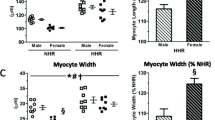Abstract
The Bio 14.6 cardiomyopathic Syrian hamster is an animal model of human idiopathic cardiomyopathy. The pathogenesis of the disease in this animal has not yet been clearly elucidated. It is well known that α- and β-adrenergic receptors are increased in the myocardium of this animal, but that isoprenaline does not produce an augmented response. We examined the activity of cardiac stimulatory GTP-binding protein (Gs), which couple with β-adrenergic receptors to stimulate adenylate cyclase, in Bio 14.6 cardiomyopathic hamsters at 90 and 160 days of age. The cardiac norepinephrine concentration was significantly increased in Bio 14.6 hamsters compared with control hamsters (F1B) at 90 days of age (1,739±120 vs 1,470±161 ng/g wet tissue weight, p<0.05). Cardiac forskolin-stimulated adenylate cyclase activities at 90 and 160 days of age were lower in the cardiomyopathic hamsters than in the F1B controls (90 days old: 98±24 vs 122±29 pmol/min/mg protein, p<0.05; 160 days old: 74±13 vs 124±28 pmol/min/mg protein, p<0.01). Cardiac Gs activities at 90 and 160 days of age were significantly lower in Bio 14.6 hamsters than those in F1B hamsters (90 days old: 204±42 vs 259±49 pmol/min/mg protein, p<0.05; 160 days old: 156±39 vs 211±60 pmol/min/mg protein, p<0.05). We thus demonstrated functional defects in cardiac Gs protein and adenylate cyclase activity in the Bio 14.6 cardiomyopathic hamsters at 90 to 160 days of age (the hypertrophic stage of cardiomyopathy). Such defects could be one possible mechanism preventing an enhanced response to β-adrenergic stimulation in this animal and could also contribute to myocardial decompensation in the late stage of cardiomyopathy.
Similar content being viewed by others
References
Homburger F, Baker JR, Nixon CW, Whitney R: Primary generalized polymyopathy and cardiac necrosis in an inbred line of Syrian hamsters. Med Exp 6: 339–345, 1962
Gertz EW: Cardiomyopathic Syrian hamster: a possible model of human disease. Prog Exp Tumor Res 16: 242–260, 1972
Karliner JS, Alabaster C, Stephens H, Barnes P, Dollery C: Enhanced noradrenaline response in cardiomyopathic hamsters; possible relation to changes in adrenoceptors studied by radioligand binding. Cardiovas Res 15: 296–304, 1981
Ikegaya T, Nishiyama T, Kobayashi A, Yamazaki N: Role of α1-adrenergic receptors and the effect of bunazosin on the histopathology of cardiomyopathic Syrian hamsters of strain Bio 14.6. Jpn Circ J 52: 181–187, 1988
Bohm M, Mende U, Schmitz W, Scholz H: Increase responsiveness to stimulation of α- but not β-adrenoceptors in the hereditary cardio-myopathy of the Syrian hamster. Intact adenosine- and cholinoceptor-mediated antagonistic effect. Eur J Pharmacol 128: 195–203, 1986
Gilman AG: G protein; transducer of receptor generated signals. Annu Rev Biochem 56: 615–649, 1987
Epstein SE, Skelton CL, Levey GS, Entman M: Adenyl cyclase and myocardial contractility. Ann Intern Med 72: 561–578, 1970
Drummond GE, Severson GL: Cyclic nucleotides and cardiac function. Circ Res 44: 145–152, 1979
Kessler PD, Cates AE, Dop CV, Feldman AM: Decreased bioactivity of the guanine nucleotide-binding protein that stimulates adenylate cyclase in hearts from cardiomyopathic syrian hamsters. J Clin Invest 84: 244–252, 1989
Sole MJ, Lo CM, Laird CW, Sonnenblick EH, Wurtman RJ: Norepinephrine turnover in the heart and spleen of the cardiomyopathic syrian hamster. Circ Res 37: 855–862, 1975
Lowry OH, Rosebrough HJ, Farr AL, Randall NS: Protein measurement with the Folin phenol reagent. J Biol Chem 193: 265–275, 1951
Ross EM, Maquire ME, Sturgill TW, Biltonen RL, Gilman AG: Relationship between the β-adrenergic receptor and adenylate cyclase. J Biol Chem 252: 5761–5775, 1977
Sternweis PC, Northup JK, Smigel MD, Gilman AG: Regulatory component of adenylate cyclase; purification and properties. J Biol Chem 256: 11517–11525, 1981
Bourne HR, Coffino RP, Tomkins GM: Selection of a variant lymphoma cell deficient in adenylate cyclase. Science (Wash. DC) 18: 750–752, 1975
Salomon Y, Londos C, Rodbell M: A highly sensitive adenylate cyclase assay. Analy Biochem 58: 541–548, 1974
Ueda E, Yoshida N, Nishimura K, Joh T, Antoku S, Tsukada K, Canno S, Kokubu T: A semautomated measurement of urinary catecholamines using high-speed ion-exchange column chromatography. Clinica Chimica Acta 80: 447–453, 1977
Wrogemann K, Nylen EG: Mitochondrial calcium overloading in cardiomyopathic hamsters. J Mol Cell Cardiol 10: 185–195, 1978
Longabaugh JP, Vatner DE, Vatner SF, Homcy CJ: Decreased stimulatory guanosine triphosphate binding protein in dogs with pressure-overload left ventricular failure. J Clin Invest 81: 420–424, 1988
Feldman AM, Cates AE, Veazey WB, Hershberger RE, Bristow MR, Baughman KL, Baumgartner WA, Dop CV: Increase of the 40,000-mol wt pertussis toxin substrate (G protein) in the failing human heart. J Clin Invest 82: 189–197, 1988
Bristow MR, Ginsburg R, Fowler M, Minobe W, Rasmussen R, Zera P, Menlove R, Shan P, Stinson E: β1-and β2-adrenergic receptor subpopulations in normal and failing human ventricular myocardium: coupling of both receptor subtypes to muscle contraction and selective β1 receptor down-regulation in heart failure. Circ Res 59: 297–308, 1986
Yatani A, Imoto Y, Codina J, Hamilton SL, Brown AM, Birnbaumer L: The stimulatory G protein of adenylyl cyclase, Gs, also stimulates dihydropyridine sensitive Ca2+ channels: evidence for direct regulation independent of phosphorylation by c-AM dependent protein kinase or stimulation by a dihydro pyridine agonist. J Biol Chem 263: 9887–9895, 1988
Rozengurt E, Legg A, Strang G, Courtenay-Luck N: Cyclic AMP: A mitogenic signal for Swiss 3T3 cells. Proc Natl Acad Sci USA 78: 4392–4396, 1981
Muraguchi A, Miyazaki K, Kehrl JH, Fauci AS: Inhibition of human B cell activation by diterpine forskolin: Interference with B cell growth factor-induced G1 to S transition of the B cell cycle. J Immunol 133: 1283–1287, 1984
Bristow MR, Hershberger RE, Port JD, Gilbert EM, Sandoval A, Rasmussen R, Cates AE, Feldman AM: β-adrenergic pathways in nonfailing and failing human ventricular myocardium. Circ 82 (suppl I): I-12–I-25, 1990
Author information
Authors and Affiliations
Rights and permissions
About this article
Cite this article
Ikegaya, T., Kobayashi, A., Hong, R.B. et al. Stimulatory guanine nucleotide-binding protein and adenylate cyclase activities in Bio 14.6 cardiomyopathic hamsters at the hypertrophic stage. Mol Cell Biochem 110, 83–90 (1992). https://doi.org/10.1007/BF02385009
Received:
Accepted:
Issue Date:
DOI: https://doi.org/10.1007/BF02385009




